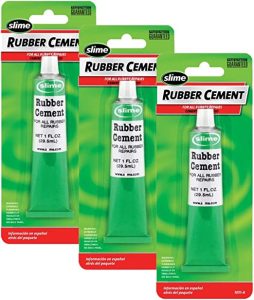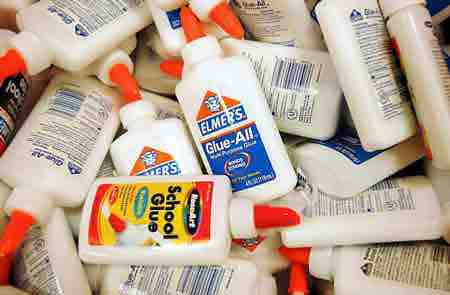Super glue is also known as cyanoacrylate (CA) glue is not a good recommendation to use on your car tires, either for fixing a punctured inner tube or patching a pinhole on your tires.
This is because super glue is brittle upon drying and also not flexible, you are likely to fail if you make a patch with it.
Sometimes, you may get lucky in filling a puncture with superglue, but as you inflate the tube, the puncture will become bigger too as the bond between the puncture and the super glue will increase.
Superglue, unlike rubber cement, doesn’t stretch. Hence, the glue will easily fail with use. So, super glue is the wrong choice to use on your car tires.
Table of Contents
How can you use tire cement on your car tire?
Tire cement is an outstanding rubber cement used for patching car tires and inner tubes, it’s more than just glue. It creates a permanent seal between the patch and the tire or inner tubes for a very long time that you can confide in.

When you suddenly get a flat tire, you can always reach out to a tire cement to patch your tires.
With the right tools, you can easily get your tire back on the road.
This is what you’ll need:
- Tire marker
- Tire patch
- Scuffer
- Rubber cement
- Butter tool for stitching
Here’s How:
- Take your tire marker to place a mark on the spot you want to patch
- With the scuffer tool, roughen the area that is quite larger than the patch you intend to use, this will make the rubber cement adhere to the tire, clean off any loose substance that will form during the scuffing
- Apply rubber cement: place the rubber cement straight to the roughened surface you just scuffed on your tire then spread evenly, you can also use the rubber cement to the patch instead, that is, you have to remove the backing of the patch first. Though, it’s not necessary if you apply rubber cement straight on the punctured area or not. Then, allow the rubber glue to dry, this will take a minute or two, when this happens the rubber cement will go from clear to cloudy. You can quicken this step by blowing on the glue.
- Apply the patch: Sometimes, the patches that come in a repair kit often have a thin foil backing, which you need to take off to enable the adhesive to hold. After removing the backing of the patch, apply the patch directly on the hole, then firmly press the patch over the punctured area, ensure that you press down the edges. Take the butter tool to stitch the patch, enabling every trapped air out.
- Kindly wait for the patch to dry off completely, then mount up the tire and inflate. Congratulations, you just succeeded in patching a tire!
What to check before using tire glue/cement?
Having to choose a chemical-based product like glue from different brands can be a bit tricky.
This is because most buyers or users skip some important factors before buying the glue. It sometimes results in a disaster. So, you should check these factors beforehand.
Nevertheless, you can easily get the best tire glue with these factors we have put together below;
- Bonding strength
- Resistance
- Quick fixing
- Drying effect
- Cost-effectivity
Bonding strength
Before you choose the glue for your car tires, you must first check the glue bonding strength, because, for patching a tire you cannot just go for any glues or brands. They will mostly fail because they will not be able to seal the patch to the tire for a long time.
Generally, Superglue has lesser sheer strength and is therefore not suitable to use on your car tires.
Rubber cement glue gives a maximum bonding strength and for that reason, it is preferable to bond tires. So, when purchasing a particular brand, make sure the glue has enough bonding capacity.
Resistance
Tire glue demands a high level of resistance than other surfaces, firstly, the tire seems to produce heat, pressure, and vibration. This can lead to damages if you feel to use quality grade glue.
The glue used on tires must have heat, water, pressure, vibration, and shock resistance. In this regard, you should go for a professional-grade glue for repairing tires.
Quick fixing
Quick fixing is an additional feature of the things to check out before using glue on your car tire. Having to choose glue all depends on what you want to use it for.
If you want to use it for small repairs or quick filling, then you should go for a quick fixing glue. This type of glue also requires a maximum bonding volume.
Drying effect
After applying the glue, some will leave stains or remnants. You should be careful about these complications.
If you apply such glue on any material and you get a stain after use, then you should give it a deep consideration before using it on your tires because removing rubber glue stains can be a bit tricky.
Cost effectivity
You should also look out for the price of the brand, whether you are a DIYer or an expert. Note that, a higher price doesn’t mean higher quality. After considering the aforementioned factors then you should also check out the cost of the glue.
Finally
Super glue can not be used on car tires or any automotive components.
We already know super glue dries hard, either the glue would crack when the tire rotates, or it would withstand rotating then lead to a hard spot on the tires’ sidewall. None seems good.
RC (Radio-controlled) cars and super glue can technically work together, if you need to fix your RC tires then you should consider using super glue but you also have to consider those factors in what to check before using tire glue, you don’t want to have regrets.
Gorilla glue, a polyurethane mix, can sometimes be a go-to because of its bonding strength and other features mentioned earlier in this article.
Rubber cement, vulcanizing cement, seems to be the only adhesive that can be used in car tires, either for patching or filling a pinhole.
Related:

